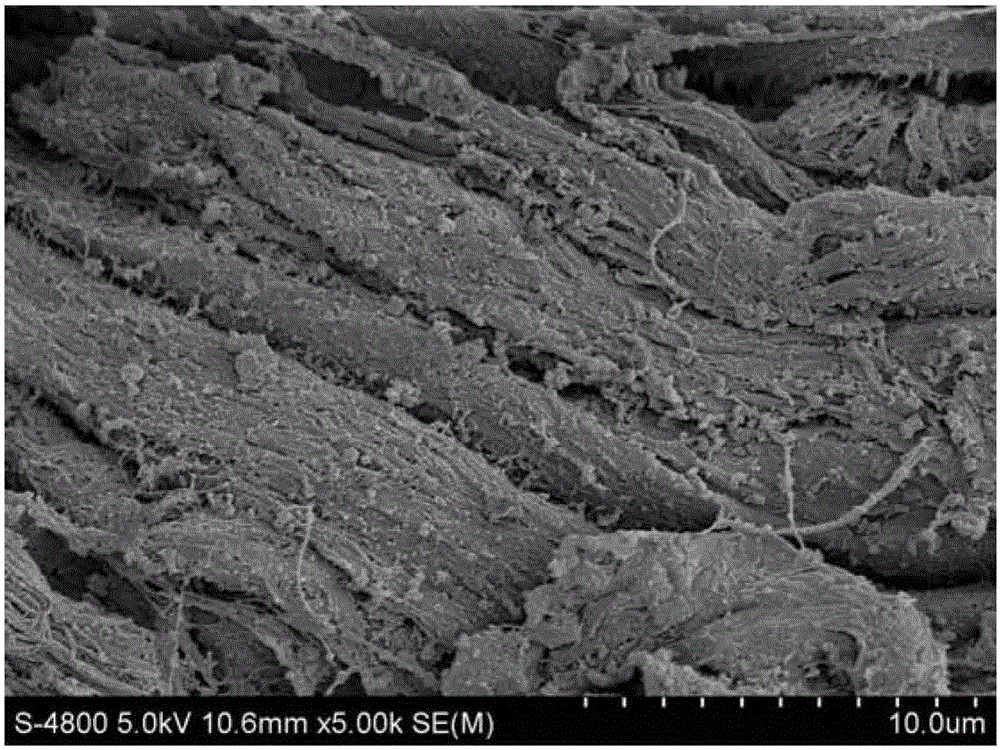Abalone processing method
A processing method and abalone technology, which are applied in the field of abalone processing of frozen products, can solve the problems of decreased permeability of complex phosphate aqueous solution, inability to rapidly gelatinize external tissue proteins, and inability to achieve good antifreeze effect, etc. The effect of draining, preventing outflow and improving quality
- Summary
- Abstract
- Description
- Claims
- Application Information
AI Technical Summary
Problems solved by technology
Method used
Image
Examples
Embodiment 1
[0027] 10kg of fresh wrinkled abalone with a brush to remove the black film, mucus and dirt on the surface of the abalone shell, then rinse in 50L of simulated seawater at 25°C for 30 minutes, drain, and place the gastropod muscles facing On the upper plate (the area of the gastropod muscle is about 0.5 square meters), spray 0.375L of protein heat denaturation protection agent at a temperature of 10°C evenly on the surface of the abalone gastropod muscle; Bake in a superheated steam conditioner for 2 minutes, then quickly transfer the abalones to 0°C ice-salt water with a sodium chloride concentration of 3.0% for cooling, drain the cooled abalones, arrange the gastropod muscles upwards, and place 0.25L protein antifreeze at 2°C is evenly sprayed on the surface of the abalone gastropod muscle, and then placed in a low-temperature and low-humidity environment for 40 minutes to reduce the temperature of the center of the abalone muscle to 2°C, air-dry the surface moisture, and f...
Embodiment 2
[0032]10kg of fresh variegated abalone is brushed to remove the black film, mucus and dirt on the surface of the abalone shell, and then rinsed in 100L of simulated seawater at a temperature of 15°C for 10 minutes, drained, and the gastropod muscle faces On the upper plate (the area of the gastropod muscle is about 0.6 square meters), spray 0.75L of protein heat denaturation protection agent at a temperature of 15°C evenly on the surface of the abalone gastropod muscle; Bake in a superheated steam conditioner for 3 minutes, then quickly transfer the abalone to 4°C ice-salt water with a sodium chloride concentration of 2.0% for cooling, drain the cooled abalone, arrange the gastropod muscles upward, and place 0.45L protein antifreeze at 8°C is evenly sprayed on the surface of the abalone gastropod muscle, and then placed in a low-temperature and low-humidity environment for 20 minutes to reduce the core temperature of the abalone muscle to 8°C, air-dry the surface moisture, an...
Embodiment 3
[0037] 10kg fresh wrinkled abalone with a brush to remove the black film, mucus and dirt on the surface of the abalone shell, then put it into 75L of simulated seawater at a temperature of 20°C for 20 minutes, drain it, and place the gastropod On the upper plate (the area of the gastropod muscle is about 0.5 square meters), spray 0.5L of protein heat denaturation protection agent at 20°C evenly on the surface of the abalone gastropod muscle; Bake in a superheated steam conditioner for 3 minutes, then quickly transfer the abalones to 2°C ice-salt water with a sodium chloride concentration of 2.5% for cooling, drain the cooled abalones, arrange the gastropod muscles upwards, and place 0.5L protein antifreeze at 5°C is evenly sprayed on the surface of the abalone gastropod muscle, and then placed in a low-temperature and low-humidity environment for 30 minutes to reduce the temperature of the center of the abalone muscle to 5°C, air-dry the surface moisture, and finally use The...
PUM
 Login to View More
Login to View More Abstract
Description
Claims
Application Information
 Login to View More
Login to View More - R&D
- Intellectual Property
- Life Sciences
- Materials
- Tech Scout
- Unparalleled Data Quality
- Higher Quality Content
- 60% Fewer Hallucinations
Browse by: Latest US Patents, China's latest patents, Technical Efficacy Thesaurus, Application Domain, Technology Topic, Popular Technical Reports.
© 2025 PatSnap. All rights reserved.Legal|Privacy policy|Modern Slavery Act Transparency Statement|Sitemap|About US| Contact US: help@patsnap.com



